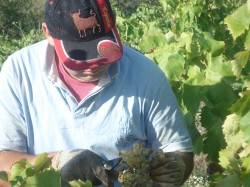 The old and hooked, craggy branches of rows upon rows of vines stretch as far as the eye can see under the late September sun, ready to be harvested. The vineyards of La Baltana Vella are the setting for the grape harvest, which commences in late August, and the sun is hot, the mid-morning temperature already nineteen degrees.
The old and hooked, craggy branches of rows upon rows of vines stretch as far as the eye can see under the late September sun, ready to be harvested. The vineyards of La Baltana Vella are the setting for the grape harvest, which commences in late August, and the sun is hot, the mid-morning temperature already nineteen degrees.
Our guide, Juan, greets us and we set off in separate vehicles before amalgamating into his van to brace the road, which is riddled with potholes.
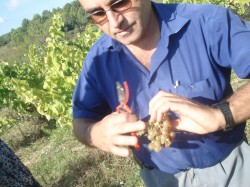 We join the workers who are picking macabeo grapes, lining up red crates at the end of each row, and expertly snipping off the premium bunches with a well-practised flick of the wrist, while the wrinkled sultanas get dropped on the ground. These grapes have been purposefully left to become almost overripe, the vines between twenty and thirty years old. I try one – it’s perfectly sweet and pops open in the mouth, and then have a go at cutting the grapes. Juan, who speaks not a work of English, and I not a word of Spanish, speaks firmly to me, gesturing to the sharp pincers of the red clippers, warning me not to cut my fingers off. He demonstrates how to cup the back of the bunch, then snip the stalk – most elementary, but there’s a certain grace to the process. And before we know it the pickers have already long overtaken us, moving swiftly along the row, one on each side of the wine to boost speed.
We join the workers who are picking macabeo grapes, lining up red crates at the end of each row, and expertly snipping off the premium bunches with a well-practised flick of the wrist, while the wrinkled sultanas get dropped on the ground. These grapes have been purposefully left to become almost overripe, the vines between twenty and thirty years old. I try one – it’s perfectly sweet and pops open in the mouth, and then have a go at cutting the grapes. Juan, who speaks not a work of English, and I not a word of Spanish, speaks firmly to me, gesturing to the sharp pincers of the red clippers, warning me not to cut my fingers off. He demonstrates how to cup the back of the bunch, then snip the stalk – most elementary, but there’s a certain grace to the process. And before we know it the pickers have already long overtaken us, moving swiftly along the row, one on each side of the wine to boost speed.
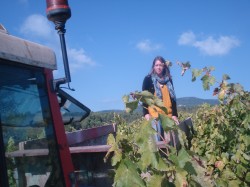
After my mistakes are straightened out (or towered up), Juan moves us on to a different grape – Parellada, which is surrounded by weeds from the recent rains. I ask Juan if they weed around the vines, but he says their presence is good for the grapes, absorbing any further rain to keep the grapes from rotting. Juan shows us how to prune the fifty-year-old vines, pointing to the notches on the bark – one centimetre between them – one for each year they cut back the wandering branches. These grapes are not so sweet and have much thicker skins, but they make a smoother and less alcoholic wine than the macabeo.
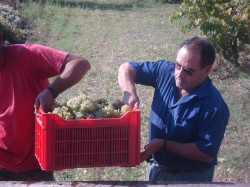
We wave goodbye to Juan who bids us thanks and, Hasta Manaña!,’ as we return on Friday to take part in a tour of the J. Miquel Jané Bodega.
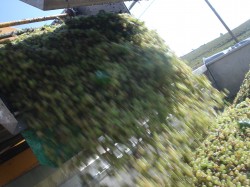
Lauren Simpson – Green, Wine Travel Writer for Wine Pleasures
0 Comments